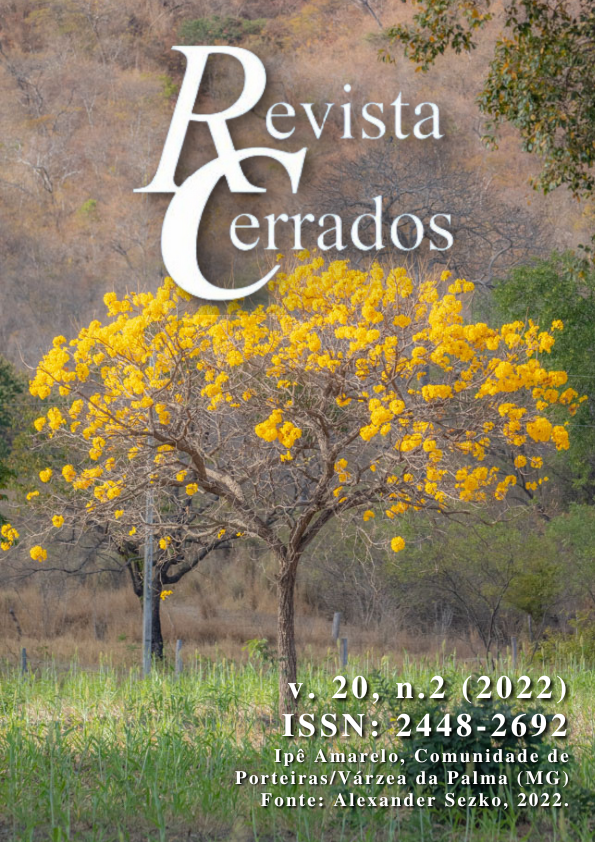THE Analysis impacts of the legislation of Permanent Protection Areas –APP on the cerrado landscape: case study of the municipality of Diamantino – MT
DOI:
10.46551/rc24482692202217Keywords:
RER, Cerrado, Diamantino – MT.Abstract
Environmental protection in Brazil is premised on the attempt to unite environmental and legislative technical issues. The main objective of this work is to analyze the impacts of environmental legislation, especially on Permanent Protection Areas, in the Cerrado landscape, taking as an example the municipality of Diamantino - MT. The data used in this research were from the Rural Environmental Registry - RER, through the CAR - SICAR System, from the Federal Technical Registry Information Bulletin and from the Cerrado Knowledge Project, with data on land use and occupation from MAPBIOMAS. When analyzing the spatial distribution of APPs in the municipality of Diamantino - MT, a fragmentation of protection areas is evident. In a few cases, preservation corridors are formed in the municipality, especially in the eastern portion of the municipality. Therefore, when analyzing APPs in general in the Cerrado, and specifically in the municipality of Diamantino, in light of the use of current environmental legislation, it is clear that the flaws contained in the norms benefit only the political and economic side. In this way, this issue, if not treated with the seriousness that it asks, can cause a great imbalance in the natural environment.
Downloads
References
BRASIL. Lei Federal 4.771 de 15 de setembro de 1965 – Institui o Código Florestal. Brasília, 1965. Disponível em: <http://www.planalto.gov.br/ccivil_03/leis/l4771.htm>. Acesso em: 29, out. 2021.
BRASIL. Lei Federal 12.651 de maio de 2012 - Dispõe sobre a proteção da vegetação nativa; altera as Leis nºs 6.938, de 31 de agosto de 1981, 9.393, de 19 de dezembro de 1996, e 11.428, de 22 de dezembro de 2006; revoga as Leis nºs 4.771, de 15 de setembro de 1965, e 7.754, de 14 de abril de 1989, e a Medida Provisória nº 2.166-67, de 24 de agosto de 2001; e dá outras providências. Brasília, 2012. Disponível em: <http://www.planalto.gov.br/ccivil_03/_ato2011-2014/2012/lei/l12651.htm>. Acesso em: 01, jun. 2022.
BRASIL. Sistema Florestal Brasileiro. Boletim Informativo do Cadastro Técnico Federal – Estados do Brasil – Estados do Brasil. Brasília, 2021. Disponível em: <https://www.florestal.gov.br/boletins-do-car/4774-boletim-informativo-abril-2020/file>. Acesso em: 29, out. 2021.
BRASIL. Sistema Florestal Brasileiro. Boletim Informativo do Cadastro Técnico Federal – Biomas do Brasil – Edição Especial - Biomas. Brasília, 2021. Disponível em: <https://www.florestal.gov.br/documentos/car/boletim-do-car/4418-revisao-boletim-car-encaminhar-07abril2020-1/file>. Acesso em: 29, out. 2021.
BRASIL. Sistema Nacional de Cadastro Ambiental Rural. Brasília, 2021. Disponível em: <https://www.car.gov.br/publico/imoveis/index>. Acesso em: 29, out. 2021.
FERNANDES, Ana Paula Donicht; ELESBÃO, Luiz Ernesto Grillo. Análise comparativa entre o atual Código Floresta Federal (Lei nº 4.771/1965) e o Projeto de lei nº 1.876/1999 aprovado pela comissão especial. Revista Enciclopédia Biosfera, [S./l.], v. 8, nº 15. Goiânia, 2012, p. 63 – 78. Disponível em: <http://www.conhecer.org.br/enciclop/2012b/ciencias%20agrarias/analise%20comparativa%20entre.pdf>. Acesso em 29, out. 2021.
FILHO, Izaac Alves Martins; NEVES, Alex Jorge das; SILVA, Grabriel E.; VIEIRA, Andrea dos S. Áreas de Proteção Ambiental e a preservação do Bioma Cerrado. Revista Brasileira de Estudos de Segurança, [S./l.], v.12. Edição Especial, São Paulo, 2019, p. 10 – 19. Disponível em: <https://revista.ssp.go.gov.br/index.php/rebesp/article/view/449>. Acesso em 29, out. 2021.
GARCIA, Letícia Couto; ELLOVITCH, Mauro da Fonseca; RODRIGUES, Ricardo Ribeiro; BRANCALION, Pedro H.S. HATSUMOTO, Marcelo H; GARCIA COUTO, Fernanda; LOYOLA, Rafael; LEWINSOHN, Thomas Michael. Análise científica e jurídica das mudanças no Código Florestal, a recente Lei de Proteção da Vegetação Nativa. Rio de Janeiro: Abeco, 2016, 43 p. Disponível em: <http://esalqlastrop.com.br/img/publicacoes/An%C3%A1lise%20cient%C3%ADfica%20e%20jur%C3%ADdica%20das%20mudan%C3%A7as%20no%20C%C3%B3digo%20%20Florestal.pdf> . Acesso em 27, out. 2021.
LAPIG. Projeto de Conhecimento do Cerrado. Laboratório de Processamento de Imagens e Geoprocessamento. Goiânia, 2021. Disponível em: <https://cepf.lapig.iesa.ufg.br/#/usodosolo>. Acesso em: 29, out. 2021.
RIBEIRO, Glaucus Vinicius Biasetto. A origem histórica do conceito de Área de Preservação Permanente no Brasil. Revista Themas, [S./l.], v. 8, nº. 01, São Paulo, 2011, p. 1 – 13. Disponível em: <https://www.terrabrasilis.org.br/ecotecadigital/pdf/origem-historica-do-conceito-de-area-de-preservacao-permanente-no-brasil.pdf>. Acesso em: 27, out. 2021.
WATANABE, S. (coord.). Glossário de ecologia. 2. ed. Editora ACIESP: São Paulo, 1997, 352 p.
Published
How to Cite
License
Copyright (c) 2022 Revista Cerrados

This work is licensed under a Creative Commons Attribution-NonCommercial-NoDerivatives 4.0 International License.
In this journal, the copyrights for published articles belong to the author (s), with the rights of the first publication belonging to Revista Cerrados. The articles are publicly accessible, free to use, their own assignments, educational assignments and non-commercial applications.


















